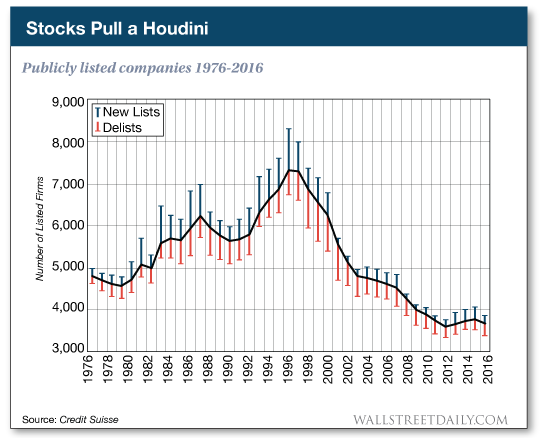It’s Friday in the Wall Street Daily nation. And that means it’s time to go to the charts!
Each week, I embrace the adage that a picture is worth a thousand words. And I handpick a few compelling charts to convey an important investment or economic insight.
This week, I’m serving up more third-party proof that patents aren’t worthless pieces of paper.
I’m denouncing a few false prophets in the mainstream financial press about tech valuations.
Last, but not least, I’m sharing an all-too-important reminder why small caps still offer the most explosive upside potential.
So let’s get to it…
Patents and the Wealth of Nations
Pardon the redundancy, but it bears repeating every time there’s fresh, third-party proof — patents matter.
For investors and, believe it or not, the wealth of nations!
A recent study by Stanford University professor and Hoover Institution senior fellow Stephen Haber demonstrates “there is a causal relationship between strong patents and innovation.”
Or more plainly, as you can see in the chart, more patents produce more wealth in the form of economic output, or GDP:

It stands to reason that the macro observation applies to the micro world, too. To wit, if strong patents produce profits for countries, strong patents should also produce profits for the individual companies that own the strongest patent portfolios.
We’ve experienced this firsthand in our premium advisory True Alpha, as countless winners came as a result of finding companies with unparalleled patent portfolios. So many times, in fact, we’ve made patents an integral part of our investment strategy.
As we’ve chronicled here before, one sector continues to power the markets to new record highs: technology.
That’s led many to take to the airwaves to proclaim we’re in the midst of another mega tech bubble. Ignore these false prophets!
Another dot-com-style collapse is not imminent.
As John Higgins at Capital Economics reassures us, “The surge in the valuation of the stock market that took place during the dot-com bubble has not been repeated.”
And this chart proves it:

While investors are exuberant, they haven’t pushed valuations above a price-earnings ratio of 30. That doesn’t mean such a sky-high valuation is a prerequisite for a collapse. But it does mean anyone saying history is repeating itself is dead wrong.
The Incredible Shrinking Stock Market
Buyouts. Breakups. Regulatory headaches. Excess venture capital funding. And bankruptcies at the hands of Amazon.com Inc (NASDAQ:AMZN)’s ever-expanding enterprise.
It doesn’t matter the cause; it’s the result that matters — fewer companies are trading on the public markets. A lot fewer.
“In less than two decades, more than half of all publicly traded companies have disappeared,” writes Jason Zweig in The Wall Street Journal.

Back in 1997, there were nearly 7,500 publicly traded stocks. Nowadays, there are fewer than 3,600, according to data from the Center for Research in Security Prices.
The upshot? Most companies are small caps and microcaps, making those the best areas of the market on which to focus for above-average profits.
As it turns out, we just put the finishing touches on a six-year beta test to identify the small-cap and microcaps stocks poised to surge by 1,000% or more.
We’re sharing the results with only a small group of investors before the next opportunity hits on July 25.
